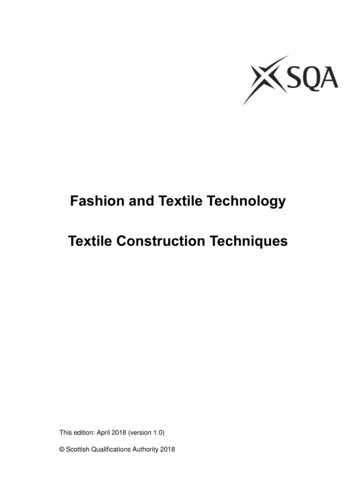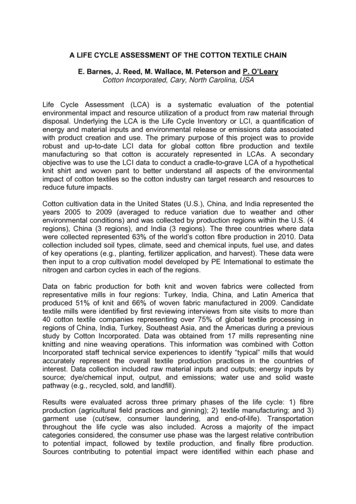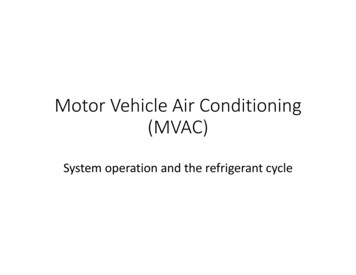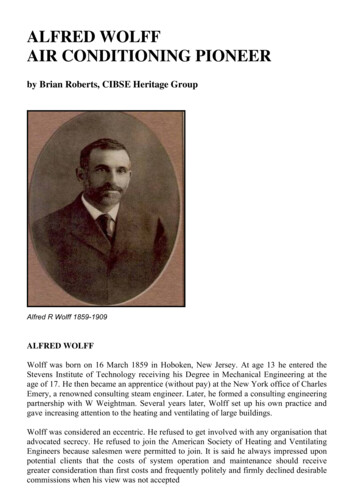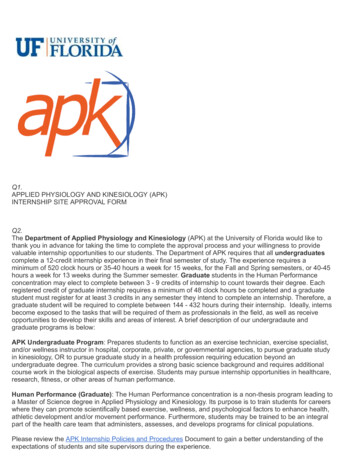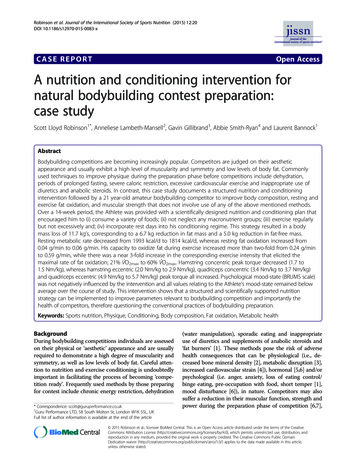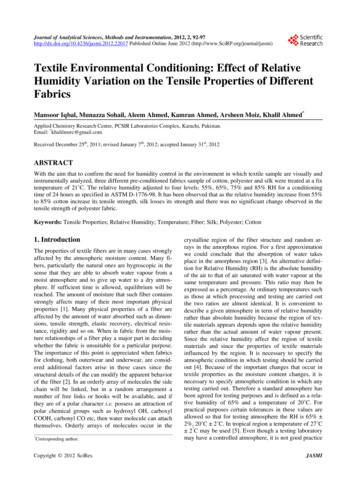
Transcription
Journal of Analytical Sciences, Methods and Instrumentation, 2012, 2, 92-97http://dx.doi.org/10.4236/jasmi.2012.22017 Published Online June 2012 (http://www.SciRP.org/journal/jasmi)Textile Environmental Conditioning: Effect of RelativeHumidity Variation on the Tensile Properties of DifferentFabricsMansoor Iqbal, Munazza Sohail, Aleem Ahmed, Kamran Ahmed, Arsheen Moiz, Khalil Ahmed*Applied Chemistry Research Centre, PCSIR Laboratories Complex, Karachi, Pakistan.Email: *khalilmsrc@gmail.comReceived December 25th, 2011; revised January 7th, 2012; accepted January 31st, 2012ABSTRACTWith the aim that to confirm the need for humidity control in the environment in which textile sample are visually andinstrumentally analyzed, three different pre-conditioned fabrics sample of cotton, polyester and silk were treated at a fixtemperature of 21 C. The relative humidity adjusted to four levels: 55%, 65%, 75% and 85% RH for a conditioningtime of 24 hours as specified in ASTM D-1776-98. It has been observed that as the relative humidity increase from 55%to 85% cotton increase its tensile strength, silk losses its strength and there was no significant change observed in thetensile strength of polyester fabric.Keywords: Tensile Properties; Relative Humidity; Temperature; Fiber; Silk; Polyester; Cotton1. IntroductionThe properties of textile fibers are in many cases stronglyaffected by the atmospheric moisture content. Many fibers, particularly the natural ones are hygroscopic in thesense that they are able to absorb water vapour from amoist atmosphere and to give up water to a dry atmosphere. If sufficient time is allowed, equilibrium will bereached. The amount of moisture that such fiber containsstrongly affects many of their most important physicalproperties [1]. Many physical properties of a fiber areaffected by the amount of water absorbed such as dimensions, tensile strength, elastic recovery, electrical resistance, rigidity and so on. When in fabric from the moisture relationships of a fiber play a major part in decidingwhether the fabric is unsuitable for a particular purpose.The importance of this point is appreciated when fabricsfor clothing, both outerwear and underwear, are considered additional factors arise in these cases since thestructural details of the can modify the apparent behaviorof the fiber [2]. In an orderly array of molecules the sidechain will be linked, but in a random arrangement anumber of free links or hooks will be available, and ifthey are of a polar character i.e. possess an attraction ofpolar chemical groups such as hydroxyl OH, carboxylCOOH, carbonyl CO etc, then water molecule can attachthemselves. Orderly arrays of molecules occur in the*Corresponding author.Copyright 2012 SciRes.crystalline region of the fiber structure and random arrays in the amorphous region. For a first approximationwe could conclude that the absorption of water takesplace in the amorphous region [3]. An alternative definition for Relative Humidity (RH) is the absolute humidityof the air to that of air saturated with water vapour at thesame temperature and pressure. This ratio may then beexpressed as a percentage. At ordinary temperatures suchas those at which processing and testing are carried outthe two ratios are almost identical. It is convenient todescribe a given atmosphere in term of relative humidityrather than absolute humidity because the region of textile materials appears depends upon the relative humidityrather than the actual amount of water vapour present.Since the relative humidity affect the region of textilematerials and since the properties of textile materialsinfluenced by the region. It is necessary to specify theatmospheric condition in which testing should be carriedout [4]. Because of the important changes that occur intextile properties as the moisture content changes, it isnecessary to specify atmospheric condition in which anytesting carried out. Therefore a standard atmosphere hasbeen agreed for testing purposes and is defined as a relative humidity of 65% and a temperature of 20 C. Forpractical purposes certain tolerances in these values areallowed so that for testing atmosphere the RH is 65% 2%, 20 C 2 C. In tropical region a temperature of 27 C 2 C may be used [5]. Even though a testing laboratorymay have a controlled atmosphere, it is not good practiceJASMI
Textile Environmental Conditioning: Effect of Relative Humidity Variation on the Tensile Properties of Different Fabricsto take in samples and immediately start to test them.Sufficient time should be allowed for the sample to reachequilibrium conditions before the test are made. A preconditioning is therefore required specially before tensiletesting at 50 C and 25% RH for 4 hours. Breakingstrength or tensile strength is the maximum force recorded in extending a test piece to breaking point. It isthe figure that is generally referred to as strength. Theforce at which a specimen breaks is directly proportionalto its cross-sectional area, therefore when comparing thestrength of different fibers, fabrics allowances have to bemade for this. The tensile force recorded at the momentof rupture is sometimes referred to as the tensile strengthat break [6]. In the present study we are trying to evaluate the effect of RH at different levels on tensile strengthof polyester, cotton and silk fibers.3. Results and DiscussionTo determine that how different levels of relative humidity can affect on the tensile properties of fabrics, threedifferent fabrics cotton, polyester and silk were first preconditioned at 50 C at 25% R.H, then they again undergoes to conditioning at 55%, 65%, 75% and 85% fordifferent levels of RH and at 21 C temperature. It hasbeen observed that different fibers shows different behavior in terms of tensile strength under the same conditions of RH and temperature. Shown in Table 2 andFigure 1, as we passes from 55% to 85% RH, cottonTable 1. Fabric weight and construction.2. Materials & Methods2.1. MaterialScoured and bleached, optical brightener free plain weavecotton, silk and polyester fabric were used as given inTable 1.2.3. Procedure Pre-conditioning of all the fabrics were carried out inAssociated Environmental System of SDL Atlas at50 C and 25% RH for 4 hrs [5]. Conditioning of samples was done in ConditioningChamber of DENCO England at 55%, 65%, 75% and85% RH and 21 C for 24 hrs [5]. For Tensile Strength determination take two sets oftest specimen one in warp and other in weft direction.Threads should be removed in approximately equalnumbers from each of the long edges of the cut stripuntil the width of the test specimen is achieved. Eachset consist of at least 5-test specimen each should be50 mm in width and 200 mm length. Tensile Strengthof fabric was determined according to standard testprocedure ISO 13934-1 (1999). [7] Fabric Weight was determined according to standardtest procedure ISO 3801 (1977)-E [8]. Ends & Picks were determined by ISO 7211-2 (1984) [9]Copyright 2012 SciRes.FabricGSM (g/m2)Cotton132 g/m222*22/80*58Polyester110.92 g/m260*30/140*72Silk70.01 g/m2102*102/187*69ConstructionTable 2. For 100% cotton (tensile strength both in warp &weft direction at different RH values).S#2.2. EquipmentsTo obtain the required relative humidity & temperature,Conditioning Chamber (Denco, England) was used. Forpre-conditioning of fabrics, Associated EnvironmentalSystem (SDL Atlas, England) was used. Tensile strengthof the fabric was carried out on CRE Tensile TestingMachine (LRX Plus, LLOYD). Fabric weight was determined on G.S.M Cutter (Hans Schmidt & Co. Germany). End & Picks were determined by Pick Glass(Waltex 6X pick glass).931234512345RH55%65%75%85%Temperature21 C21 C21 C21 CTime24 hrs24 hrs24 hrs24 hrsWarpWarpWarpWarpWarpMean warpWeftWeftWeftWeftWeftMean 6N819.4NFigure 1. Tensile strength of cotton in warp and weft direction at different RH values.JASMI
94Textile Environmental Conditioning: Effect of Relative Humidity Variation on the Tensile Properties of Different Fabricsincreases its strength. Fundamentally, it is due to the decrease in cohesive force between the chain molecules dueto swelling and the release of internal strain by swelling.Thus in the native cellulosic fiber, such as cotton, therelease of internal strain between the long chain molecules predominant and this increase the fiber strengthbecause of a more uniform internal distribution of stress.Also the average chain length (DP) in cotton is five timesgreater than regenerated cellulose, so that the individualmolecules in cotton may be expected to have more pointof adhesion and so to process greater internal strain [10].In its mature dried form, nearly 90 per cent by weight ofthe cotton fibre is cellulose. In fact the cellulose found incotton fibres is the purest form of cellulose found in allplants. The cellulose in cotton fibres is mostly (88 - 96.5per cent). The non-cellulose components (4 - 12 per cent)are located either on the outer layers of the cotton fibre inthe cuticle and primary cell wall or inside the residualprotoplasm called the lumen. The secondary wall of mature fibres is primarily cellulose in its most highly crystalline and oriented form Figure 2 shows the structure ofthe cellulose molecules in cotton. From a physical viewpoint the molecule is a ribbon-like structure of linkedsix-member rings each with three hydroxyl groups (OH)on the C2, C3 and C6 atoms projecting out of the planeof the ribbon. As well as providing structural stability thehydroxyl groups allow extensive intermolecular hydrogen bonding with many molecules, including water. Theaccessibility of water to these hydroxyl groups dependson the spacing between crystal lattice planes. From acompletely dry state, water molecules will form hydrogen bonds with hydroxyl groups that are not alreadylinked within crystalline regions [11].As indicated from Table 3 and Figure 3, the silk fabric shows a reverse result as compared to cotton, as wemove from 55% towards 85% R.H, the tensile strengthdetermined were gradually decreased. The silk fiber arelinear, fibroin polymer that forms a chemical point ofview, differ from wool fiber due to their different aminoacid composition. More precisely, silk fiber does notcontain disulphide bonds. This Chemical difference mayaffect the morphology of the crystal, producing only theβ-configuration, which together with the high degree ofcrystallinity is responsible for high tensile strength of silkfiber. In wet conditions the tensile strength of silk fiberdecreases because water molecules hydrolyze a significant number of hydrogen bond [12]. Silk is a natural fiber secreted as a continuous filament by the silk worm,Table 3. For silk (tensile strength both in warp & weft direction at different RH values).RHS#Copyright 2012 SciRes.65%75%85%Temperature21 C21 C21 C21 CTime24 hrs24 hrs24 hrs24 452N403NMean 66N438N412N365N5Figure 2. Assembly of cellulose molecules in a sheet. Hydrogen bonds are shown by dotted lines. Circled carbonatoms; C2, C3 and C6, show location of hydroxyl (-OH)groups.55%Weft460N440N413N367NMean Weft463.20N441.6N414.6N368.2NFigure 3. Tensile strength of silk in warp and weft directionat different RH values.JASMI
Textile Environmental Conditioning: Effect of Relative Humidity Variation on the Tensile Properties of Different FabricsBombyx mori. Silk consists essentially fibroin polymerand in the raw state coated with a gum Sericin that isusually removed before spinning. The silk polymer iscomposed of 16 different amino acids linked with peptide bonds. The important chemical groups of the silkpolymer are the peptide groups which gives rise to hydrogen bonds, and the carboxyl and amine groups whichgives rise to the salt linkages. The silk filament is strong.This strength is due to its linear, β-configuration polymerand very crystalline polymer system. These two factorspermit more hydrogen bonds to be formed in a muchregular manner. When wet silk losses its strength. This isdue to water molecules hydrolyzing a significant numberof hydrogen bonds and in the process weakening the silkpolymer. The greater crystalline of silk polymer systemallows fewer molecules enter into the polymer system ofsilk [13].RH-R1-NH-CH-CO-NH-CH-CO-NH-CH-CO-OOCCOO- OHThe general formula for the polypeptide polymer. Depending upon the type of radical R, R1, R2, the polypeptide polymer would be identical either as being a silkfibroin polymer or a wool keratin polymer.The results obtained from Table 4 and Figure 4, polyester fabric shows that it is strong to very strong fabricbecause of their extremely crystalline polymer system.This allows the formation of very effective Van derWaals forces as well as the very weak hydrogen bond,resulting in very good tensile properties one associatedwith polyester polymer. The tensile strength of polyesterfiber remains unaltered when we passes from 55% to85% RH. This occurs because of the completely hydrophobic and extremely crystalline polyester polymer system, which resists the entry of water molecules to anysignificant extant [14].Polyester fiber is the condensation polymerizationproduct of ethylene glycol and terepthalic acid. The wordester is the name given to salt formed from the reactionbetween an alcohol and an acid. Ester is organic salt andpolyester means many organic salts. Chemically it is apolymer of polyethylene glycol terphlate. The importantchemical groups in the polyester polymer are the ethylene group, -CH2-, the slightly polar carbonyl group, -CO-,and the ester group, -OCO- group. The one of the distinguishing characteristics of polyester is attributed to thebenzene rings in the polymer chain. The aromatic character leads to chain stiffness, preventing the deformationof disordered regions, which results in weak Van derWaals interaction forces between chains. The aromatic,carboxyl and aliphatic molecular groups are nearly planarCH22nPolyethylene TerpthlateTable 4. For polyester (Tensile Strength both in warp &weft direction at different RH values).S#nCopyright 2012 SciRes.in configuration and exist in a side-by-side arrangement.The cohesion of polyester chains is a result of hydrogenbonds and van der Waals interactions, caused by dipoleinteraction, induction and dispersion forces among thechains. The insignificant amount of moisture, which maybe present in polyester textile materials, exists as a molecular film of water on the surface of filaments of staplefiber [15].RHR29555%65%75%85%Temperature21 C21 C21 C21 CTime24 hrs24 hrs24 hrs24 935N942N937N938.8NMean warp935.2N 58N858N861NMean Weft860N863.8N862.2N862.8NFigure 4. Tensile strength of polyester in warp and weftdirection at different RH values.JASMI
96Textile Environmental Conditioning: Effect of Relative Humidity Variation on the Tensile Properties of Different FabricsFigures 5(a) and (b) indicates the combined effect ofTensile Strength both in Warp and Weft direction of silk,cotton and polyester at different RH values. It has beenalso observed that the tensile strength calculated in weftdirection for each cotton, polyester and silk fiber comesout to be minimum as compared to the warp direction,furthermore fluctuation in the RH have no significanteffect on tensile results of polyester fabric and a pronounced effect were found in case of cotton and silk fiber.All fibers, whether hydrophilic or hydrophobic, absorbsome water from an atmosphere having a relative humidity above 0%. The amount of moisture contained by afiber when its own relative humidity is equal to that ofthe surrounding atmosphere, and the point at which fiberwill neither gain nor lose moisture to the atmosphere iscalled equilibrium moisture content. The equilibrium moisture content will remain unchanged unless the relative(a)humidity is changed; lowering the relative humidity ofthe environment will result in the fiber losing moistureuntil new equilibrium moisture content is reached. Similarly, increasing the relative humidity of the environmentwill result in the fiber gaining moisture until new equilibrium moisture content is reached.Relative humidity (RH) governs the amount of moisture contained in materials at equilibrium with the environment. This is almost independent of temperature. Asrelative humidity changes, the object’s water contentadjusts to the new relative humidity level, creating a newequilibrium. At higher RH, there is more water in fiber[16].Silk and cotton are hydrophilic fibers, meaning thattheir surface has bonding sites for water molecules. Therefore, water tends to be retained in the hydrophilic fibers,which have poor moisture transportation and release;they have the ability to absorb moisture from the surroundings. At equilibrium the moisture content of silk isabout 11% and that of cotton is about 8%. Polyester is ahydrophobic fiber; meaning that their surface has fewbonding sites for water molecules. Hence, they tend notto get wet and have good moisture transportation andrelease. Its moisture content is low as 0.4%, it absorbsmoisture very slowly and dries quickly. Cotton and silkabsorbs moisture very quickly but dries slowly. As therelative humidity (RH) of the surrounding increases, themoisture absorption also increases and as the relativehumidity decreases the drying of fibers or “Desorption”takes place [17].If two identical samples of fibre, one wet and one dry,are placed in a standard atmosphere of 65% RH, it mightbe expected that they would both eventually reach thesame value of regain. However, this is not the case as theone that was originally wet is found to have a higher regain than the one that was originally dry; this differenceis due to hysteresis between moisture uptake and moisture loss [18].Exposure to moisture for prolonged period of timemay cause to degradate the textile fibes. Under higherhumid conditions for prolonged period of time may causeto change the dimension, texture and shape of the textilefibers. As the relative humidity decreases, desorption ordrying of textile fibers takes place. It is not reversibleunder drying conditions, because under lower humidityconditions some textile fibers may losses and some increases their strength. Controlled humid conditions arerequired for particular fabric [19].4. Conclusion(b)Figure 4. (a) Combined effect of Tensile Strength in Warpdirection at different RH values; (b) Combined effect ofTensile Strength in Weft direction at different RH values.Copyright 2012 SciRes.The present research work has demonstrated that textilesamples exhibits often significant change in tensilestrength testing as relative humidity fluctuates around therecommended standard condition of 65% RH. In case ofJASMI
Textile Environmental Conditioning: Effect of Relative Humidity Variation on the Tensile Properties of Different Fabricssynthetic fiber polyester, we found no significant difference in tensile properties due to the hydrophobic character of this fiber. In natural fiber cotton we found a pronounced effect in tensile properties by fluctuate the relative humidity from 65% to 85%. In cotton the tensilestrength gradually increases. The silk fiber shows a reverse result as compared to cotton, the tensile strengthdecreases as we passes from 65% to 85% RH. It is recommended that environmental conditions must be specified and continually controlled so as to minimize tensilestrength results variation for all samples
Pre-conditioning of all the fabrics were carried out in Associated Environmental System of SDL Atlas at 50 C and 25% RH for 4 hrs [5]. Conditioning of samples was done in Conditioning Chamber of DENCO
